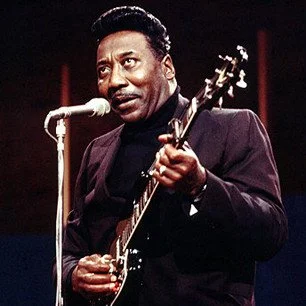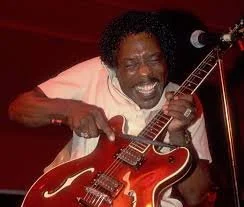Buddy Guy Blues Blog
Muddy Waters influenced Buddy & all of rock and roll
The first festival I went to was Chazz Fest at the Family Circle Cup on Daniel Island (now the Credit One Stadium) in 2006. I was 14 years old and my dad prepared me by having me listen to Drink Smalls, The Drive By Truckers, Al Green, and Buddy Guy. We saw Drink Smalls off on a side clay court a short walk through the woods on a really cool totally outdoor stage. Next I remember seeing Drive By Truckers at a slightly larger stage with a different more intoxicated crowd (Jason Isbell was still in the band).I was excited to see the headliner Al Green, but knowing from my dad that Buddy Guy influenced Jimi Hendrix, I was the most excited for his set. I remember Al Green rubbing roses on his sweat drenched self and throwing them into the crowd to screaming women. Little did I know Charleston legends like Danielle Howle who would later offer to make my first record in 2010(we declined), and Cary Ann Hearst had made appearances that day. Cary Ann Hearst’s Dust and Bones had just been released but I wouldn’t get hip to her and her husband’s local Charleston music for another year or two. We chose to see Buddy over Cary Ann and I don't regret it, I’m sure she loathed sharing a time slot. I remember Buddy touring through the music of famous blues guitar players and saying "My good friend Eric Clapton played the guitar like this" bending and peeling his notes before jumping into Cream’s 1967 psychedelic rock song "Strange Brew". His entire performance dedicated to preserving the legacy of the blues. He shared stories of the days of the Blues and stories from his life. These stories left an impression on a still forming historically inclined musical mind.
Buddy Guy was born 1938 in the bayous of Louisiana where he suffered the typical racial discrimination of the day and was forced to pick cotton for measly wages in the mid 1940's and early 50's. By the time he was 19 he had taught himself how to play the guitar and had demos recorded by a local Baton Rouge DJ. In 1958, Buddy Guy won a guitar competition in Chicago, getting him signed to Cobra Records, where he made an album with the not yet infamous Ike Turner before moving over to Chess Records. Chess never let him be his signature self, with Leonard Chess the founder describing his guitar playing as "all noise". This was nothing new; white record producers had edited influential Black artists since the dawn of the business. This was usually in attempt to suppress Black culture and mitigate any crossover into white communities. From 1959-67, Chess Records never let Buddy record himself how he sounded live. By 1967, there were many white bands, which you could say we're all about "making noise." The hippie era had ushered in a new breed of musical lovers. Those listening to Eric Clapton of Cream, Jimmy Page of the Yardbirds( & later Led Zeppelin), and Keith Richards of the Rolling Stones were keenly aware that this music they were hearing was a unique slice of Black Americana. They wanted to get straight to the source with the British Invasion placing American Blues guitar players centerstage as the heavy hitters for influencing these new legendary sounds that shaped popular rock music as we now know it. Immediately these artists began highlighting their heroes and according to Buddy Guy himself “They gave us careers”. Buddy Guy moved to Vanguard Records in 1968, recording "A Man and the Blues," his first characteristic guitar sound release. He had still been driving trucks on the side until that time. In 1969, several big white Rock N Roll players (Eric Clapton, Jimmy Page, and Stephen Stills) brought him to England for a "supershow," and by 1972, he bought his first blues club, The Checkerboard Lounge, on the Southside of Chicago. Today he still owns Buddy Guy Legends in Chicago which has been bringing the Blues to life since 1989.
Last night, I saw Buddy Guy for the second time, 19 years later. He's still got it. I'm so fortunate that I was able to take my wife, Emily, and our good friend, Elder Carlie Towne. Buddy is turning 88 in twelve days, and it was absolutely incredible to see such a legend on stage once again telling his story. Not only did he perform his music, but he ran through numbers by Willie Dixon, Muddy Waters, Eddie Cooly, John Lee Hooker, Eric Clapton, and more. The highlight was his heavy prompting of the crowd to sing along on Skin Deep (a song he made with Derek Trucks) with the chorus, "Skin Deep, Skin Deep, Underneath we're all the same". To sing this message in the South in 2024 amidst the strife of an upcoming presidential election in a majority white crowd was truly remarkable. Sadly, Buddy can't play the guitar like he did 19 years ago, and he has to get help on stage from the impressive Ric Hall. Buddy still starts the guitar off on every song and finishes strong, but in the middle, he focuses on his singing (which is remarkably strong). He was intentional with every note that he played, even using a towel to make a slow noise on his guitar. In one memorable section, he placed his guitar on top of an amplifier with all the band members and crew nervously watching the 87-year-old man’s every move. He took a drumstick & a towel, muffling the neck, and somehow still played Sunshine of Your Love by Cream. This show was originally scheduled for September of 2023 at the Gaillard and due to flooding in Charleston it had to be rescheduled. We are so glad we got to see Buddy together.
In the past two years, I've been so blessed to have seen some of the most incredible live music performances of my life with my wife, Emily. Together, we have seen 91-year-old Willie Nelson, the Rolling Stones, Dead & Company, Neil Young & Crazy Horse, John Fogerty, and so much more.
Do your Homework and learn about the history of music in America!!
Long Live American Music
Peace & Love,
Will


